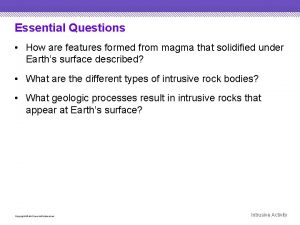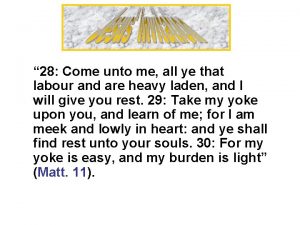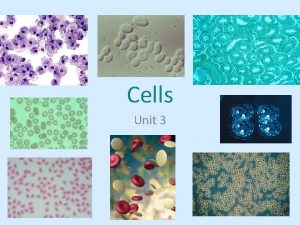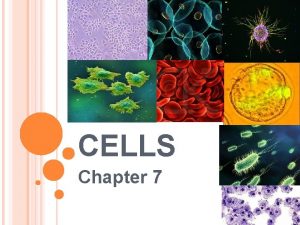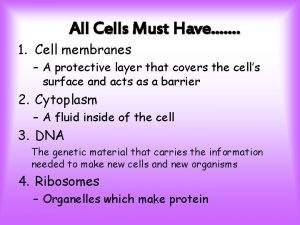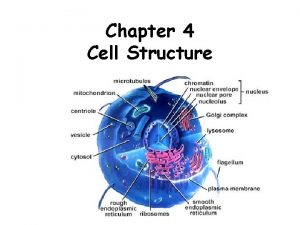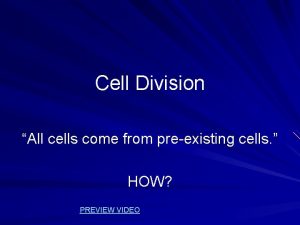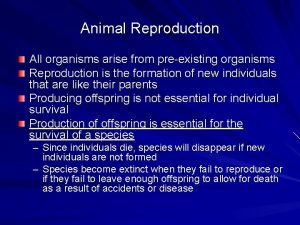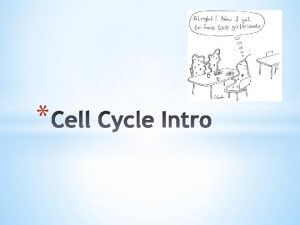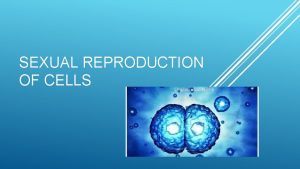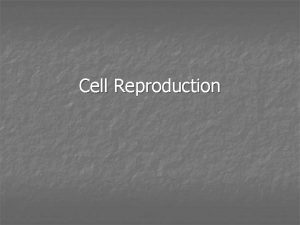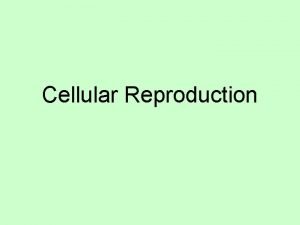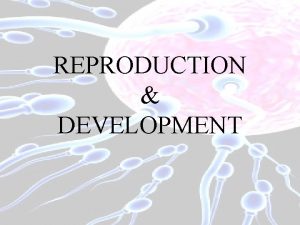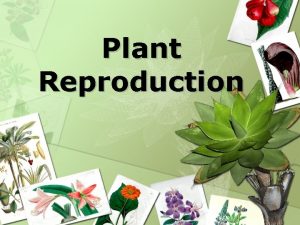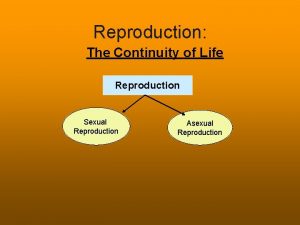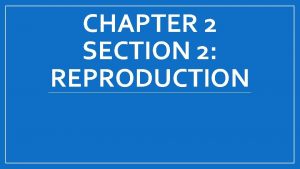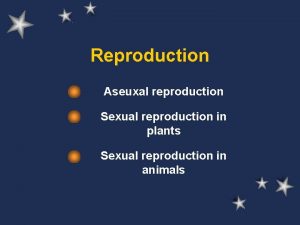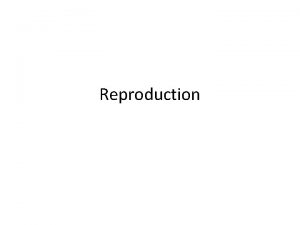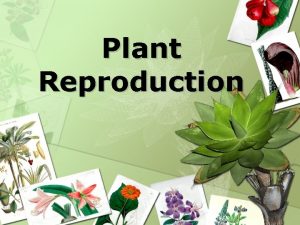REPRODUCTION All cells come from preexisting cells Essential



























































- Slides: 59

REPRODUCTION • All cells come from pre-existing cells. • Essential for the continuation of a species

Why do cells divide? Cells need to remain small. A greater surface area to volume ratio is needed to maintain homeostasis • for reproduction – one celled organisms (clones) • for growth & development – from fertilized egg to multi-celled organism • for repair – replace cells that die from normal wear & tear or from injury

Asexual Reproduction (12 min) http: //www. brainpop. com/science/cellularlifeandgenetics/asexualreproduction/

Types of Reproduction video clips on asexual reproduction - Bing Videos Parents ASEXUAL One parent Results in clones (genetically identical) Two parents – SEXUAL egg and sperm sex cells (gametes) Variation Mate Selection Very little or no variation in offspring No mate selection needed Great variation (diversity) due to crossing over (exchanging genetic info) Varying degrees of mate selection

METHODS OF ASEXUAL REPRODUCTION video clips on asexual reproduction - Bing Videos 1. BINARY FISSION – DNA copies itself and then cell divides in half – results in 2 identical, equally sized offspring (cells) – EX: bacteria, amobea – video clips on asexual reproduction - Bing Videos AMOBEAS

2. BUDDING • NUCLEUS DIVIDES EQUALLY, CYTOPLASM DOES NOT • RESULTS IN different sized “BUDS” offspring • EX: YEAST, HYDRA • Video About Asexual Reproduction - Bing Videos

3. SPORULATION – “SPORE FORMATION” – single specialized cells made by mitosis that grow (germinate) into a new organism under proper conditions (WATER AND FOOD)! – EX: OCCURS IN MOLD AND OTHER FUNGI Spores – How Is Bread Mold Formed - Bing Videos

4. REGENERATION: is the ability to replace body parts. • Example – Starfish, worms, hydras To what extent can regeneration occur in humans? Why? Humans can regenerate certain organs like the skin but not old body parts Video: Sea Star Regeneration | Educational Video | Watch. Know. Learn Educational Videos | Watch. Know. Learn

5. VEGETATIVE PROPAGATION Asexual Reproduction Educational Videos | Watch. Know. Learn – can be produced asexually from the roots, stems and leaves of an existing plant. Natural: – Bulbs – tulips, onions and lilies – Runners– Grass and strawberries – Tuber -potato Artificial: – Cuttings – segments separated from the plant and placed in soil to grow a new plant – How to Start an African Violet From a Leaf - Bing Videos – Grafting – attaching a branch or stem of one plant on to another

Vegetative Propagation PROS CONS • Plants are identical • Can be wiped out – good if productive by disease or a & strong disaster (flooding • Faster than planting a seed • Produces Seedless fruit or a drought) • Can be more susceptible to insecticides

Mitosis video (23 min) http: //www. brainpop. com/science/cellularlifeandgenetics/mitosis/ (2: 09)

STAGES/PHASES OF THE CELL CYCLE M I T O S I S • • • Interphase Prophase Metaphase Anaphase Telophase Cytokinesis Pneumonic Device I Pray More At The Church

Cell Cycle Cell cycle video http: //www. youtube. com/watch? v=3 kp. R 5 RSJ 7 SA&fea ture=related http: //www. cellsalive. com/mitosis. htm 14 I P M A T C

Mitosis: Animal v. Plant

INTERPHASE When cell is NOT dividing! l Performs all metabolic activites l Obtains nutrients, grows, reads its DNA l Replicates DNA before the cell divides l

PROPHASE Centrioles move to opposite poles l Spindle fibers form l Nucleolus and Nuclear Membrane disappear l Chromatin condenses into chromosomes l Centrioles

METAPHASE l Chromosomes line up IN THE MIDDLE Spindle Centriole

ANAPHASE l Daughter chromosomes pull apart

TELOPHASE (Exact opposite of Prophase) Nuclear membrane and nucleolus reform n Spindle fibers disappear n Chromosomes stretch out n

CYTOKINESIS: CYTOKINESIS ( cyto = cell n Cell membranes of animal cells pinch in and divide in the middle. n Plant cells create a cell plate which becomes the cell wall after division kinesis = movement ) Cell Plate

KEYS TO MITOSIS l Original cell has complete set of chromosomes l l This is known as DIPLOID or 2 N One division results in 2 DAUGHTER CELLS l l l No genetic material exchanged Cells are GENETICALLY IDENTICAL Daughter Cells are also DIPLOID or 2 N l l IN SINGLE CELLED ORGANISMS: l Method of reproduction (ASEXUAL) l l Ex. Original cell has 46 chromosomes, daughter cells will have 46 chromosomes Protists, some Algae, and Molds IN MULTI-CELLED ORGANISMS: Mitosis used for GROWTH and REPLACEMENT of BODY (somatic) CELLS (skin, liver, heart etc…) l

Overview of mitosis http: //www. sumanasinc. com/webcontent/animations/content/mitosis. html Copy DNA Line Up Separate Divide

Stem Cells and Telomeres l Never Say Die Scientific American Frontiers - Season 10 l The Clock of Life- http: //chedd-angier. com/frontiers/season 10. html (start at 15: 11 minutes) (9 minutes) l Your turn: Complete the 2 article reviews on TELOMERES l WHAT ARE STEM CELLS” https: //www. youtube. com/watch? v=j. F 2 i. Xpo. G 5 j 8 l Your turn: Complete the article review on Stem Cells

MEIOSIS: Cell Division to form Gametes Video: (2 min) http: //www. youtube. com/watch? feature=player_embedded&v=D 1_-m. QS_FZ 0

SEXUAL REPRODUCTION Why do you share some but not all characters of each parent? What are the rules of this sharing game? At one level, the answers lie in meiosis. l http: //www. iteachbio. com/ Life%20 Science/Life. Funct ionsand. The. Cell/Meiosis. mov l http: //www. iteachbio. com/ Life%20 Science/Life. Funct ionsand. The. Cell/Sexual. Re production. mov

Meiosis: SEXual Reproduction!! A. What is meiosis? A form of CELL DIVISION by which sex cells called GAMETES (egg and sperm), are produced. l Takes place in reproductive structures called GONADS (ovaries and testes) l B. How does meiosis occur? l Chromosomes replicate and EACH CELL DIVIDES TWICE - (meiosis I and meiosis II) II l Each sex cell has half the number of CHROMOSOMES l Diploid (2 n) haploid (n)

C. Why do we need meiosis? It is necessary to halve the number of chromosomes going into the sex cells (gametes) l Why halve the chromosomes in sex cells? 1. l At fertilization the male and female sex cells will provide ½ of the chromosomes each – so the offspring has genes from both parents (23 chromosomes from each parent = 46 total)

2. ALLOWS FOR GENETIC VARIATION OF OFFSPRING • gametes of offspring do not have same genes as gametes from parents 3. Genetic diversity is important for the evolution of populations and species. from Dad We’re mixing things up her e! variation from Mom offspring new gametes made by offspring

Let’s review some vocabulary first: 1. Homologous chromosomes (homologs): l A PAIR of chromosomes carrying the SAME GENES (ONE from each parent) l HOMOLOGOUS = same information l Humans have 23 PAIRS 2. Sister CHROMATIDS: l 2 “identical” strands of DNA that make up each member of a homologous pair

3. DIPLOID (2 N): l having 2 of each chromosome type l ex. mitosis always STARTS and RESULTS in a diploid number (46) l ex. meiosis always STARTS with diploid number (46) 4. HAPLOID (N): l A cell (always a gamete) that contains ½ the number of CHROMOSOMES l Meiosis results in cells with ½ NUMBER OF CHROMOSOMES (23)! 46 23 egg 46 23 sperm Diploid (2 n) Haploid (n) meiosis Draw a this d nd label ia in th gram of yo e box ur no tes

5. Fertilization - THE JOINING OF SEX CELLS l ½ genetic (egg) + ½ genetic (sperm) = 1 genetically whole organism (n=23) egg + (n=23) Sperm = (2 n=46) zygote . egg n=23 sperm n=23 = 2 n=46 zygote

6. Zygote is a FERTILIZED egg Fertilization Embryo Zygote Mitosis

7. KARYOTYPE l A method of organizing the chromosomes of a cell in relation to number, size, and type.

• There are two categories of chromosomes: • Sex chromosomes – X, Y • Autosomes – 1, 2, 3, …. . (numbers 1 -22 in humans) XY chromosome - male XX chromosome - female

8. CROSSING-OVER: • Process when homologous chromosomes “cross” each other and EXCHANGE genes • SOURCE OF VARIATION-gives NEW COMBINATIONS of mom and dad’s genes in one chromosome • Reason why you aren’t exactly like your siblings!

Images of Chromosomes crossing over Go to Section:

9. Gametogenesis l Making gametes (sex cells- EGG and SPERM)

Basic diagram of Meiosis- Ova Oogenesis l Formation of egg cell (ova) l Results in 1 functional gamete and 3 polar bodies 46 different chromosomes 23 46 chromosomes Female Human Pre-Gamete Replication and Crossing. Over First cell division 1 functional ovum and 3 polar bodies 46 different chromosomes

Basic diagram of Meiosis- Sperm 46 Spermatogenesis: chromosomes l Formation of sperm cells l Results in 4 functional gametes Male Human Pre-Gamete Replication and Crossing. Over 46 different chromosomes 46 First cell division different chromosomes 4 functional sperm After 2 nd cell division 23 23

Meiosis Animation

MEIOSIS I: HOMOLOGOUS CHROMOSOMES SEPARATE PRIOR TO MEIOSIS Sister chromatids 1. Chromosomes replicate in parent cell. MEIOSIS I Tetrad (4 chromatids from homologous chromosomes) 2. Synapsis of homologous chromosomes. Crossing over of non-sister chromatids. 3. Tetrads migrate to middle of cell. 4. Homologs separate.

MEIOSIS II: SISTER CHROMATIDS SEPARATE MEIOSIS II 5. Cell divides. 6. Chromosomes begin moving to middle of cell. 7. Chromosomes line up at middle of cell. 8. Sister chromatids separate. 9. Cell division results in four daughter cells.

Meiosis Parent cell – chromosome pair Chromosome s copied 1 st division - pairs split 2 nd division – produces 4 gamete cells with ½ the original no. of chromosomes

Meiosis I l Metaphase I l Homologous chromosomes align along middle of cell

Meiosis I l Anaphase I l Spindle fibers pull homologous chromosomes toward opposite poles

Meiosis I l Telophase I and Cytokinesis Nuclear membranes reform l Cell separates into 2 cells l

Meiosis II l Each cell still has 2 chromatids l The goal of meiosis II is to get 1 chromatid into each cell! l Prophase II Happens very quickly l Spindle fibers appear l Nuclear membranes disappear l

Meiosis II l Metaphase II l Chromatids align at middle of cells

Meiosis II l Anaphase II l Sister chromatids separate and move toward poles

Meiosis II l Telophase II and Cytokinesis l Chromatids are at opposite poles l Nuclear membranes reappear l Cells divide and result in 4 genetically different gametes that are HAPLOID (N)!

I II – like mitosis BUT twice Crossing over occurs • Crossing over (during prophase I) brings about VARIATION!!!!!

ADVANTAGES OF SEXUAL REPRODUCTION 1. Sexual reproduction increases individual VARIATION within a SPECIES l Asexual Reproduction (Mitosis): l Results in offspring = to parents l Sexual Reproduction (Meiosis): l Results in offspring that are not = to parents 2. GENETIC DIVERSITY may produce some organisms that are ADAPTABLE to non favorable conditions: l Susceptibility to PATHOGENS l ENVIRONMENTAL changes

DISADVANTAGES OF SEXUAL REPRODUCTION 1. Sex SLOWS RATE of Reproduction! l Sexual reproduction should decline in frequency relative to asexual reproduction l Sexual Reproduction: l Only FEMALES produce offspring, therefore fewer are produced l Asexual Reproduction: l All individuals can produce offspring

2. Errors In Inheritance: Genetic disorders occur for various reasons: l NONDISJUNCTION: l Failure of a pair of chromosomes to separate during gamete formation l ABNORMAL numbers of one or more chromosomes is usually, but not always, fatal


l Includes Genetic Disorders Like: l DOWN’S SYNDROME (chromosome #21)

Comparing Mitosis & Meiosis – 1 min l Animation Mcgraw meiosis http: //highered. mheducation. com/sites/007 2495855/student_view 0/chapter 28/animati on__stages_of_meiosis. html

KEYS TO MEIOSIS l Original cell has complete set of chromosomes l (Diploid or 2 N) 2 divisions result in 4 DAUGHTER CELLS (gametes: 1 ova or 4 sperm) l Genetic material is exchanged during CROSSING OVER l CHROMOSOMES “criss-cross” EXCHANGING GENES l Daughter cells (gametes) are genetically different l Daughter cells (gametes) are now HAPLOID or N ( ½ the original # ) l Ex. If original cell has 46 chromosomes, gametes that result from meiosis will have 23 chromosomes l OCCURS ONLY IN MULTICELLUAR, SEXUALLY REPRODUCING ORGANISMS l

COMPARISON OF MITOSIS AND MEIOSIS Characteristic Mitosis (Asexual) Meiosis (SEX) Occurs in BODY (Somatic) cells REPRODUCTIVE cells Function GROWTH, DEVELOPMENT, REPLACEMENT, REPAIR Make GAMETES (egg and sperm) Results in 2 daughter cells (clones) 4 daughter cells (all diverse) Chromosome # DIPLOID (2 n)=46 chromosomes HAPLOID (n) = 23 chromosomes Reproduction Type ASEXUAL – 1 parent SEXUAL – 2 parents # Cycles 1 cell division (IPMAT) 46 46 46 2 cell divisions (PMAT x 2) 46 46 46 23 23
 Dykes and sills
Dykes and sills Chapter 8 cellular reproduction cells from cells
Chapter 8 cellular reproduction cells from cells Mogan's cevicheria
Mogan's cevicheria Asexual reproduction cell division
Asexual reproduction cell division Hare lynx
Hare lynx Sexual and asexual reproduction in animals venn diagram
Sexual and asexual reproduction in animals venn diagram Plamatic acid
Plamatic acid Name a line containing point a
Name a line containing point a Come holy spirit come inflame our souls with love lyrics
Come holy spirit come inflame our souls with love lyrics Hey come on out short story summary
Hey come on out short story summary Come thou fount come thou king
Come thou fount come thou king Past participle
Past participle Come come emmanuel son of god appear
Come come emmanuel son of god appear Come mi chiamo come mi chiamo
Come mi chiamo come mi chiamo Come lord jesus come and be born in our hearts lyrics
Come lord jesus come and be born in our hearts lyrics Come home come home jesus is calling
Come home come home jesus is calling Come mi vedo io
Come mi vedo io Come on come on turn your radio on
Come on come on turn your radio on Come mi chiamo come mi chiamo
Come mi chiamo come mi chiamo Saber past tense
Saber past tense Come in come in and sit down
Come in come in and sit down Come in come in and sit down
Come in come in and sit down Lab-samaro
Lab-samaro Onodi cells
Onodi cells Alpha intercalated cells
Alpha intercalated cells Parafollicular cells vs follicular cells
Parafollicular cells vs follicular cells Haploid vs diploid venn diagram
Haploid vs diploid venn diagram Somatic vs germ cells
Somatic vs germ cells Red blood cells and white blood cells difference
Red blood cells and white blood cells difference What organisms are made of eukaryotic cells
What organisms are made of eukaryotic cells Animal rights and animal welfare venn diagram
Animal rights and animal welfare venn diagram Prokaryotic vs eukaryotic cells venn diagram
Prokaryotic vs eukaryotic cells venn diagram Why did robert hooke name cells “cells”?
Why did robert hooke name cells “cells”? Masses of cells form and steal nutrients from healthy cells
Masses of cells form and steal nutrients from healthy cells Pseudostratified vs simple columnar
Pseudostratified vs simple columnar Cuál es la diferencia entre la célula animal y vegetal
Cuál es la diferencia entre la célula animal y vegetal Prokaryotic cells
Prokaryotic cells Cells and life lesson 1 answer key
Cells and life lesson 1 answer key Adattamento delle piante all'ambiente
Adattamento delle piante all'ambiente Come unto me all ye that labor
Come unto me all ye that labor O come all ye faithful chinese lyrics
O come all ye faithful chinese lyrics 齐来崇拜 生命圣诗
齐来崇拜 生命圣诗 Come unto me, all who are weak lyrics
Come unto me, all who are weak lyrics Forward motion, conflict, and change of mood all come from
Forward motion, conflict, and change of mood all come from Come to me all who are weary song
Come to me all who are weary song O come all ye faithful public domain
O come all ye faithful public domain All you who are thirsty
All you who are thirsty You can all come to my party
You can all come to my party Were pilgrims on a journey of a narrow road
Were pilgrims on a journey of a narrow road Cell transport
Cell transport Cell to tissue to organ to organ system to organism
Cell to tissue to organ to organ system to organism All cells have
All cells have All cells must have
All cells must have All cells exhibit basic structural similarities
All cells exhibit basic structural similarities All cells must contain
All cells must contain Help ever hurt never
Help ever hurt never Interventi sociali rivolti all'infanzia e all'adolescenza
Interventi sociali rivolti all'infanzia e all'adolescenza Above all power above all kings
Above all power above all kings I work all night i work all day
I work all night i work all day Basic communication operations in parallel computing
Basic communication operations in parallel computing
